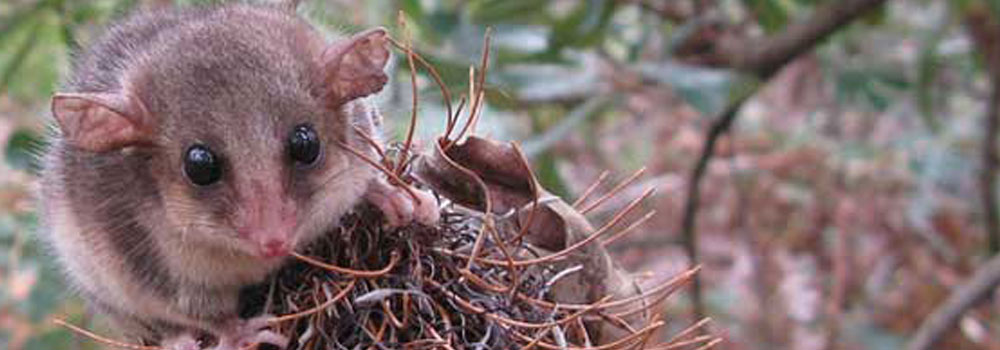Fauna

Eastern Pygmy-possum
Common Name: Pygmy-possum
Scientific Name: Cercartetus nanus
Conservation Status: Vulnerable species in New South Wales (Threatened Species Conservation Act).
Description
Eastern Pygmy-possums are tiny (15 to 43 grams) active climbers, with almost bare, prehensile (capable of curling and gripping) tails, and big, forward-pointing ears. They are light-brown above and white below. Adults have a head and body length between 70 – 110 mm and a tail length between 75 – 105 mm.
Distribution
They are distributed in suitable habitat in the south-east corner of Australia and Tasmania. Suitable habitat includes rainforest to sclerophyll forest and tree heath provided there is food available. They are patchily distributed with a low abundance.
There have been records for a number of locations in the Ku-ring-gai Chase National Park however outside there are only two. One was seen in Church Point in 1969 and another was rescued and released in Ingleside in 2005. This low number of sightings should not be seen as indicative of numbers however as they are a cryptic species and may still occur in larger areas of bushland.
Habitat and ecology
- Found in a broad range of habitats from rainforest through sclerophyll (including Box-Ironbark) forest and woodland to heath, but in most areas woodlands and heath appear to be preferred, except in north-eastern NSW where they are most frequently encountered in rainforest.
- Feeds largely on nectar and pollen collected from banksias, eucalypts and bottlebrushes; an important pollinator of heathland plants such as banksias; soft fruits are eaten when flowers are unavailable.
- Also feeds on insects throughout the year; this feed source may be more important in habitats where flowers are less abundant such as wet forests.
- Shelters in tree hollows, rotten stumps, holes in the ground, abandoned bird-nests, Ringtail Possum (Pseudocheirus peregrinus) dreys or thickets of vegetation, (e.g. grass-tree skirts); nest-building appears to be restricted to breeding females; tree hollows are favoured but spherical nests have been found under the bark of eucalypts and in shredded bark in tree forks.
- Appear to be mainly solitary, each individual using several nests, with males having non-exclusive home-ranges of about 0.68 hectares and females about 0.35 hectares.
- Young can be born whenever food sources are available, however most births occur between late spring and early autumn.
- Agile climbers, but can be caught on the ground in traps, pitfalls or postholes; generally nocturnal.
- Frequently spends time in torpor especially in winter, with body curled, ears folded and internal temperature close to the surroundings.
Source and additional information: Environment.nsw.gov.au and Northern Beaches Council
Nest boxes
The loss of hollow bearing trees has now been declared a key threatening process by the NSW Scientific Committee. This means that the loss of hollow bearing trees is recognised as having a direct link with the loss of certain native wildlife species. In urban areas natural tree hollows are limited in number especially as hollows generally form in trees that are dead, dying or have suffered some damage or insect attack. These trees are often seen as a danger to people and property and are therefore readily removed. Where this is the case next boxes can provide a den for animals dependent on hollows. Nest boxes should not be considered a suitable replacement for tree hollows, but a temporary measure, or as a supplement where hollows are already lacking. Hollow bearing trees should still be retained and planned for the future wherever possible. In order to mitigate the loss of hollows in the case of necessary tree removal resulting from development applications, Council regularly imposes conditions to install nest boxes. This gives the benefit of creating additional nesting and roosting habitat where hollows may be lacking. If you have conditions for provision of nest boxes on your development application consent, the following information will be very useful.
Location and installation
Nest box locations should be quiet, up high (over 4m), safe from predators (e.g. cats) and sheltered from prevailing winds and the midday sun. The box itself should be positioned so that the animal(s) can easily get in and out and can easily reach and climb onto nearby branches. Nest boxes may also suffer invasion by feral bees, ants and non-native bird species such as Indian Mynas. In this case, the nest box may have to be temporarily removed. Cats and rats can also be a problem in some areas. To prevent these animals accessing the nest box, a metal sheet (approximately 1m wide) can be wrapped around the base of the tree or pole ensuring the metal sheet is high enough to prevent predators jumping over it.
Monitoring your nest box
Monitoring your next box will give you a great indication as to its success or otherwise. This can be easily achieved using binoculars and a notebook. The collection of information on faunal activity can provide invaluable information as well as being a rewarding experience. Monitoring nest boxes is also necessary for the control of pest species such as cats, rats, bees, insects or Indian Mynas and other exotic birds.
Maintenance Levy
Do you want to help?
Consider placing a nesting box in your yard.
Hand-made nesting boxes made are only $25 each and are easy to install.
Contact Lesley Stevens by email for more information or to order.